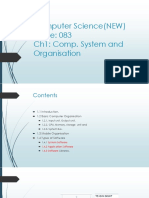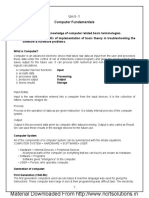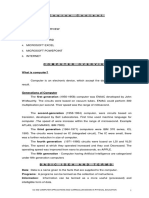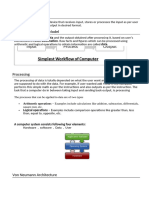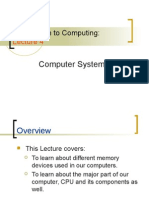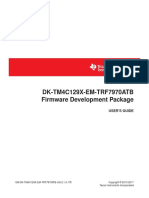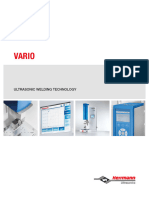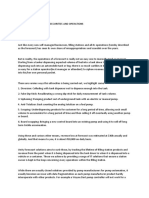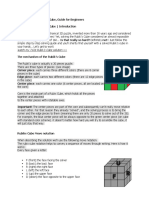CCT Notes Unit
CCT Notes Unit
Uploaded by
lalansingh549Copyright:
Available Formats
CCT Notes Unit
CCT Notes Unit
Uploaded by
lalansingh549Original Description:
Copyright
Available Formats
Share this document
Did you find this document useful?
Is this content inappropriate?
Copyright:
Available Formats
CCT Notes Unit
CCT Notes Unit
Uploaded by
lalansingh549Copyright:
Available Formats
UNIT- I
COMPUTER FUNDAMENTALS
COMPUTER GENERATIONS
Each generation of computer is characterized by a major technological development that
fundamentally changed the way computers operate, resulting in increasingly smaller, cheaper,
more powerful, and more efficient and reliable devices.
The first generation computers used vaccumtubes
Machine language was used for giving the instructions.
These computer were large in size & their programming was difficult task.
The electricity consumption was very high.
First Generation (1940-56):
Vaccumtubes were replaced by transistors.
Assembley language was used for giving the instructions.
They required only 1/10 of power required by tubes.
This generation computers generated less heat & were reliable.
The first operating systemdeveloped in this generation.
Second Generation(1956-63):
Replaced transistors with Integrated circuit known as chip.
From Small scale integrated circuits which had 10 transistors per chip, technology
developed to MSI circuits with 100 transistors per chip.
These computers were smaller, faster & more reliable.
High level languages invented in this generation.
The Third Generation(1964-71):
LSI & VLSI were used in this generation.
As a result microprocessors came into existence.
The computers using this technology are known as Micro Computers.
High capacity hard disks were invented.
There was great development in data communication.
Very High level languages invented in this generation.
The fourth Generation(1972- present):
Fifth generation computing devices, based on artificial intelligence, are still in
development, though there are some applications, such as voice recognition, that are
being used today.
The use of parallel processing and superconductors is helping to make artificial
intelligence a reality.
The Fifth Generation (Present & Beyond):
- 1 -
C++ SIMPLIFIED BY SKB FOR CLASS-XI -TAFS
What is a computer?
Computer is an advanced electronic device that takes raw data as input and processes it according
to the set of instructions (program) provided and gives the desired result which can be stored for
future use.
Basic Characteristics of a Computer
FUNCTIONAL UNITS OF A COMPUTER
Input Devices: Those devices which help to enter data into computer system. Eg. Keyboad,
Mouse, Touchscreen, Barcode Reader, Scanner, MICR, OMR etc.
Bar code Reader MICR used in Bank OMR(Used for answer sheet evaluation)
INPUT
Accepts Data-
Raw facts and
figures
PROCESSING
processes
data
OUTPUT
Produces
output
STORAGE
Stores results
C
h
a
r
a
c
t
e
r
i
s
t
i
c
s
Speed
Computer can perform millions (1,000,000) of instructions and
even more per second.
Accuracy
The degree of accuracy of computer is very high and every
calculation is performed with the same accuracy.
Diligence
A computer is free from iredness, lack of concentration, fatigue,
etc.
Versatility
It means the capacity to perform completely different type of
work.
Storage
It has the power of storing any amount of information or data for
any numbers of years.
No IQ
It is a dumb machine and it cannot do any work without instruction
from the user. It cannot take its own decisions.
No Feeling
It does not have feelings or emotion, taste, knowledge and
experience.
- 2 -
C++ SIMPLIFIED BY SKB FOR CLASS-XI -TAFS
Output Devices
Devices which help to display the processed information. Eg. Monitor, Printer, Plotter, Projector
Printer Plotter Projector
Central Processing Unit (CPU)
The ALU and the CU of a computer system are jointly known as the central processing unit. You
may call CPU as the brain of any computer system. It is just like brain that takes all major
decisions, makes all sorts of calculations and directs different parts of the computer functions by
activating and controlling the operations.
Arithmetic Logical Unit (ALU)
After you enter data through the input device it is stored in the primary storage unit. The actual
processing of the data and instruction are performed by Arithmetic Logical Unit. The major
operations performed by the ALU are addition, subtraction, multiplication, division, logic and
comparison. Data is transferred to ALU from storage unit when required. After processing the
output is returned back to storage unit for further processing or getting stored.
Control Unit (CU)
The next component of computer is the Control Unit, which acts like the supervisor seeing that
things are done in proper fashion. Control Unit is responsible for coordinating various operations
using time signal. The control unit determines the sequence in which computer programs and
instructions are executed. Things like processing of programs stored in the main memory,
interpretation of the instructions and issuing of signals for other units of the computer to execute
them. It also acts as a switch board operator when several users access the computer
simultaneously. Thereby it coordinates the activities of computers peripheral equipment as they
perform the input and output.
Memory
Random Access Memory (RAM) is the best known form of computer memory. The Read and write
(R/W) memory of a computer is called RAM. The User can write information to it and read
information from it. With Ram any location can be reached in a fixed ( and short) amount of time
after specifying its address. The RAM is a volatile memory, it means information written to it can
be accessed as long as power is on. As soon as the power is off, it cannot be accessed. so this
PRIMARY MEMORY
RAM
D-RAM S-RAM
ROM
PROM EPROM EEPROM
CACHE
FLASH
- 3 -
C++ SIMPLIFIED BY SKB FOR CLASS-XI -TAFS
mean RAM computer memory essentially empty. RAM holds data and processing instructions
temporarily until the CPU needs it.
RAM is considered random access because you can access any memory cell directly if you know
the row and column that intersect at that cell. RAM is made in electronic chips made of so called
semiconductor material, just like processors and many other types of chips.
There are two basic types of RAM :
Dynamic RAM
Static RAM
D-RAM loses its stored information in a very short time (for milli sec.) even when power supply is
on. D-RAMs are cheaper & lower.
S-RAM retains stored information only as long as the power supply is on. Static RAMs are costlier
and consume more power. They have higher speed than D-RAMs.
ROM : Read only memory: Its non volatile memory, i.e., the information stored in it, is not lost
even if the power supply goes off. Its used for the permanent storage of information. It also
possesses random access property. Information cannot be written into a ROM by the
users/programmers. In other words the contents of ROMs are decided by the manufactures.
The following types of ROMs are listed below :
(i) PROM : Its programmable ROM. Its contents are decided by the user. The user can store
permanent programs, data etc in a PROM. The data is fed into it using a PROM programs.
(ii) EPROM : An EPROM is an erasable PROM. The stored data in EPROMs can be erased by
exposing it to UV light for about 20 min. Its not easy to erase it because the EPROM IC has to be
removed from the computer and exposed to UV light. The entire data is erased and not selected
portions by the user. EPROMs are cheap and reliable.
(iii) EEPROM (Electrically Erasable PROM) : The chip can be erased & reprogrammed on the board
easily byte by byte. It can be erased within a few milliseconds. There is a limit on the number of
times the EEPROMs can be reprogrammed, i.e.; usually around 10,000 times.
Flash Memory: Its an electrically erasable & programmable permanent type memory. It uses one
transistor memory all resulting in high packing density, low power consumption, lower cost &
higher reliability. Its used in all power, digital cameras, MP3 players etc.
Cache Memory:
Cache memory is random access memory (RAM) that a computer microprocessor can access more
quickly than it can access regular RAM. As the microprocessor processes data, it looks first in the
cache memory and if it finds the data there (from a previous reading of data), it does not have to
do the more time-consuming reading of data from larger memory. It is of two types- L1 cache is
on the same chip as the microprocessor. L2 is usually a separate static RAM (SRAM) chip.
SECONDARY MEMORY
Hard Disk (Local Disk), Optical Disks: CD-R, CD-RW, DVD-R, DVD-RW, Pen Drive, Floppy Disks,
Memory Cards, External Hard Disk, Blu Ray Disk
Blu-Ray Disk:
Blu-ray (not Blue-ray) also known as Blu-ray Disc (BD), is the name
of a new optical disc format. The format offers more than five times
the storage capacity of traditional DVDs and can hold up to 25GB on a
single-layer disc and 50GB on a dual-layer disc. While current optical
disc technologies such as DVD, DVDR, DVDRW, and DVD-RAM rely
on a red laser to read and write data, the new format uses a blue-
violet laser instead, hence the name Blu-ray.
- 4 -
C++ SIMPLIFIED BY SKB FOR CLASS-XI -TAFS
MEMORY UNITS
kilobyte (KB) 2
10
megabyte (MB) 2
20
gigabyte (GB) 2
30
terabyte (TB) 2
40
petabyte (PB) 2
50
exabyte (EB) 2
60
zettabyte (ZB) 2
70
yottabyte (YB) 2
80
BOOTING
The process of loading the system files of the operating system from the disk into the computer
memory to complete the circuitry requirement of the computer system is called booting.
Types of Booting:
Cold Booting: If the computer is in off state and we boot the computer by pressing the power
switch ON from the CPU box then it is called as cold booting.
Warm Booting: If the computer is already ON and we restart it by pressing the RESET button
from the CPU box or CTRL, ALT and DEL key simultaneously from the keyboard then it is called
warm booting.
HOME ASSIGNMENT - 1
HW 1.1 What is a computer? Discuss about any four basic characteristics of a computer.
HW 1.2 Write atleast two important characteristics of each generation of computers.
HW 1.3 Draw a diagram showing the functional components of a computer.
HW 1.4 Write the functions of control unit and ALU.
HW 1.5 Name 5 input and 5 output devices.
HW 1.6 What do you understand by term booting? Explain about cold and warm booting.
HW 1.7 Name the various units of memory.
HW 1.8 What do you mean by primary storage and secondary storage?
HW 1.9 Differentiate between RAM and ROM.
HW 1.10 Differentiate between volatile and non-volatile memory.
HW 1.11 What is a cache? Why do we use cache?
HW 1.12 What is blue-ray-disk?
HW 1.13 Convert 10 GB into bytes.
Headphone
- 5 -
C++ SIMPLIFIED BY SKB FOR CLASS-XI -TAFS
SOFTWARE CONCEPTS
Hardware includes every computer-related object that you can physically touch and handle like
disks, screens, keyboards, printers, chips, wires, central processing unit, floppies, USB ports, pen
drives etc. Whereas software includes every computer-related program that you cannot feel with
the physical senses for example, system operating system, an anti-virus program, the web
browser etc. Program is a set of Instructions and a Programmer is that who develops the program.
What is a computer language?
The language, which the user employs to interact with computer or write computer programs, is
known as computer or programming language. Examples are: C/C++, Java, Pascal, COBOL, Python,
FORTRAN etc.
MACHINE LANGUAGE
Machine Language was the first generation programming language which is hard wired in
processors. It is also referred as machine code or object code. Machine language instructions are
built into the hardware of a particular computer. It is a collection of binary digits or bits that the
computer reads and interprets. Machine language is the finite number of instructions that only a
computer can understand.
ASSEMBLY LANGUAGE
Assembly language is a second generation programming language. Also referred as low-level
programming language, it is designed for specific processors. Assembly language uses structured
commands as substitutions called mnemonics. The mnemonics are used for bits used by machine
language allowing humans to read the code easier than looking at binary.
A system software called assemblers were designed to convert mnemonic codes into machine
language instructions. In general assembly mnemonic instruction consists of Opcode (CPU
instruction) and operand (data value).
Here is an example of assembly language code.
mov ax,2C00h - Move number (2C00H) to AX register
inc cx - Increment value stored in CX register
int 20h - Call Interrupt 20H
Since mnemonics are one to one related to machine code instructions, assembly language is
machine dependent.
Programming Language
Low Level
Machine Langauage (1 GL)
Assembly Language (2GL)
High Level
C/C++, Java, Pascal, COBOL,
FORTRAN (3GL)
SQL, DBMS, spreadsheets
(4GL)
PROLOG (5GL)
- 6 -
C++ SIMPLIFIED BY SKB FOR CLASS-XI -TAFS
HIGH-LEVEL LANGUAGES
High level languages or 3rd generation languages use English like statements to code computer
instructions. These are programmers' friendly since these languages are machine-independent
and developers can concentrate on problem solving logic rather than on hardware structure.
These languages require system programs called compilers (and interpreters) which translate
English-like statements (source code) to machine code.
Examples of high level languages are: C, C++, Java, COBOL, BASIC, FORTRAN, Pascal etc.
Q. What are fourth generation languages (4GL)? How are 4GLs different from third generation
languages?
Answer: Fourth generation languages (4GLs) are English like statements commonly used to access
databases. These are called command languages or non-procedure languages because these
languages help the user obtain desired results without writing long program or procedures (as it is
done in 3rd generation languages). 4GLs are more oriented towards non-technical users and
reduce coding errors. Examples of 4GLs are SQL, DBMS, spreadsheets, FOCUS, report generator
etc.
Types of SOFTWARE
System Software
Operating System
Compiler
Interpreter
Assembler
Utility Software
Anti Virus
File Management
tools
Compression tools
Disk Management
tools
Application software
Office Tools
Word Processor
Presentation Tool
Spreadsheet Package
Database Management
System
Domain specific tools
School Management
System
Inventory Management
System
Payroll System,
Financial Accounting
Hotel Management
Reservation System
Weather Forecasting
System
- 7 -
C++ SIMPLIFIED BY SKB FOR CLASS-XI -TAFS
OPERATING SYSTEM
Need for operating system
At the simplest level, an operating system does two things:
It manages the hardware and software resources of the system. In a desktop computer,
these resources include such things as the processor, memory, disk space, etc. (On a cell
phone, they include the keypad, the screen, the address book, the phone dialer, the
battery and the network connection.)
It provides an Interface for the applications to deal with the hardware without having to
know all the details of the hardware.
Types of operating system
Interactive (GUI based) & CUI Based: CUI stands for Character User Interface, it means
that u have to type commands to interact with your computer. E.g. - In DOS for everything
we type the commands. GUI stands for Graphical User Interface, it means that you do not
need to type commands to interact with your computer instead youu have to click with the
help of mouse on the icons of readymade commands. E.g. Windows
Single User Systems: Provides a platform for only one user at a time. They are popularly
associated with Desk Top operating system which run on standalone systems where no
user accounts are required. Example: DOS.
Multi User Systems: Provides regulated access for a number of users by maintaining a
database of known users. Refers to computer systems that support two or more
simultaneous users. Another term for multi-user is time sharing. Ex: All mainframes are
multi-user systems. Example: Unix
Multi-tasking and Single-tasking Operating Systems: When a single program is allowed to
run at a time, the system is grouped under the single-tasking system category, while in
case the operating system allows for execution of multiple tasks at a time, it is classified as
a multi-tasking operating system.
Real Time: RTOS is therefore an operating system that supports real-time applications by
providing logically correct result within the deadline required. Basic Structure is similar to
regular OS but, in addition, it provides mechanisms to allow real time scheduling of tasks.
Functions of
Operating
System
Processor
Management,
Memory
Management,
File
Management
and
Device
Management
- 8 -
C++ SIMPLIFIED BY SKB FOR CLASS-XI -TAFS
Distributed: An operating system that manages a collection of many independent
computers and makes them appear to the users of the system as a single computer.
Commonly used operating systems
UNIX: Pronounced yoo-niks, a popular multi-user, multitasking operating system developed at Bell
Labs in the early 1970s. UNIX was one of the first operating systems to be written in a high-level
programming language, namely C. This meant that it could be installed on virtually any computer
for which a C compiler existed.
LINUX: Pronounced lee-nucks or lih-nucks. A freely-distributable open source operating system
that runs on a number of hardware platforms. The Linux kernel was developed mainly by Linus
Torvalds and it is based on Unix. Because it's free, and because it runs on many platforms,
including PCs and Macintoshes, Linux has become an extremely popular alternative to proprietary
operating systems.
Windows: Microsoft Windows is a series of graphical interface operating systems developed,
marketed, and sold by Microsoft. Microsoft introduced an operating environment named
Windows on November 20, 1985 as an add-on to MS-DOS in response to the growing interest in
graphical user interfaces (GUIs).
[2]
Microsoft Windows came to dominate the world's personal
computer market with over 90% market share, overtaking Mac OS, which had been introduced in
1984.The most recent client version of Windows is Windows 7; the most recent server version is
Windows Server 2008 R2; the most recent mobile version is Windows Phone 7.5.
SOLARIS: Solaris is a Unix operating system originally developed by Sun Microsystems. It
superseded their earlier SunOS in 1993. Oracle Solaris, as it is now known, has been owned by
Oracle Corporation since Oracle's acquisition of Sun in January 2010.
BOSS: BOSS (Bharat Operating System Solutions) GNU/Linux distribution developed by C-DAC
(Centre for Development of Advanced Computing) derived from Debian for enhancing the use of
Free/ Open Source Software throughout India. This release aims more at the security part and
comes with an easy to use application to harden your Desktop.
Mobile OS: A mobile operating system, also called a mobile OS, is an operating system that is
specifically designed to run on mobile devices such as mobile phones, smart phones, PDAs, tablet
computers and other handheld devices. The mobile operating system is the software platform on
top of which other programs, called application programs, can run on mobile devices.
Android: Android is a Linux-based mobile phone operating system developed by Google.
Android is unique because Google is actively developing the platform but giving it away for
free to hardware manufacturers and phone carriers who want to use Android on their
devices.
Symbian: Symbian is a mobile operating system (OS) targeted at mobile phones that offers
a high-level of integration with communication and personal information management
(PIM) functionality. Symbian OS combines middleware with wireless communications
through an integrated mailbox and the integration of Java and PIM functionality (agenda
and contacts). The Symbian OS is open for third-party development by independent
software vendors, enterprise IT departments, network operators and Symbian OS
licensees.
- 9 -
C++ SIMPLIFIED BY SKB FOR CLASS-XI -TAFS
LANGUAGE TRANSLATOR
LANGUAGE PROCESSORS: Since a computer hardware is capable of understanding only machine
level instructions, So it is necessary to convert the HLL into Machine Level Language. There are
three Language processors:
Compiler: Compilers are system programs, which translate a source code written in high level
language to an object code. When a programmer writes a program code, he runs the compiler
program, which translates it into an executable program. Then you run or execute the translated
program.
In general a compiler works in multiple stages. In the first stage it checks if the code follows the
high level language grammar and semantics. If there is any error(s) it aborts the compilation
process and reports the errors. If there is no error, it generates intermediate object code. In the
second stage, linker which is a system program part of compiler combines various object code
files into a single executable binary file (machine code).
Interpreter: It is a translator which converts the HLL language into machine language line by line.
It takes one statement of HLL and converts it into machine code which is immediately executed. It
eliminates the need of separate compilation/run. However, It is slow in processing as compare to
compiler.
Assembler:
Assembler is a system program which translates an assembly language code or program to
machine code format. Generally assemblers are written by the manufacturers of processors
because assemblers are machine dependent.
OPEN SOURCE CONCEPTS
Open-source software (OSS) is computer software with its source code made available and
licensed with an open-source license in which the copyright holder provides the rights to study,
change and distribute the software for free to anyone and for any purpose.
Mozilla Firefox. GNU/Linux, Apache Web server
Shareware: Software for which license fee is payable after some time limit, its source code is not
available and modification to the software are not allowed.
Shareware is software that is distributed free on a trial basis with the understanding that the user
may need or want to pay for it later. Some software developers offer a shareware version of their
program with a built-in expiration date (after 30 days, the user can no longer get access to the
- 10 -
C++ SIMPLIFIED BY SKB FOR CLASS-XI -TAFS
program). Other shareware (sometimes called liteware) is offered with certain capabilities
disabled as an enticement to buy the complete version of the program.
Proprietary Software: Proprietary Software is the s/w that is neither open nor freely available,
normally the source code of the Proprietary Software is not available but further distribution and
modification is possible by special permission by the supplier.
Freeware, not to be confused with free software, is a type of proprietary software that is offered
for use free of monetary charges. However, as is the case with other types of proprietary
software, there are generally severe restrictions on its use and the source code is kept secret.
Examples of freeware include Adobe's Acrobat Reader and Microsoft's Internet Explorer web
browser.
HOME ASSIGNMENT 2
HW 2.01 Differentiate between software and hardware with suitable examples.
HW 2.02 Why do we need an operating system?
HW 2.03 What are the functions of an operating system.
HW 2.04 Differentiate between CUI and GUI operating system.
HW 2.05 Name one CUI and one GUI based operating system.
HW 2.06 What is a Real Time O.S.?
HW 2.07 Explain distributed O.S.
HW 2.08 Write a note on Mobile O.S.
HW 2.09 What is an assembler?
HW 2.10 Write two differences between a compiler and an interpreter.
HW 2.11 What are open source software (OSS)? Name few OSS.
HW 2.12 Explain the terms shareware, Proprietary Software and freeware.
You might also like
- Training Manual CFM56-5B: Basic EngineDocument97 pagesTraining Manual CFM56-5B: Basic EngineJivendra Kumar100% (8)
- What Is Computer?Document17 pagesWhat Is Computer?Narender SinghNo ratings yet
- PPS Complete NotesDocument116 pagesPPS Complete NotesMOHAMMAD ANISHNo ratings yet
- Study Material XI Comp Final CkeckedDocument12 pagesStudy Material XI Comp Final CkeckedroseNo ratings yet
- Computer LiteracyDocument11 pagesComputer LiteracyDebottam DasNo ratings yet
- Unit 8 - Information and Communication TechnologyDocument42 pagesUnit 8 - Information and Communication TechnologyAbhishek Dali100% (1)
- Unit 1, 2 Part BDocument58 pagesUnit 1, 2 Part BHarish Singh GhughtyalNo ratings yet
- Class-11 CH-1 Computer SystemDocument15 pagesClass-11 CH-1 Computer SystemNEELMAY THAKURNo ratings yet
- Computer Science (NEW) Code: 083 Ch1: Comp. System and OrganisationDocument37 pagesComputer Science (NEW) Code: 083 Ch1: Comp. System and OrganisationTeenu GamerzNo ratings yet
- Computer FundamentalDocument19 pagesComputer Fundamentalredcard53No ratings yet
- Computer FundamentalsDocument19 pagesComputer FundamentalsPaneendra KumarNo ratings yet
- Objective:: Computer FundamentalsDocument14 pagesObjective:: Computer FundamentalsRamana Parameswaran100% (1)
- 41 PDFDocument135 pages41 PDFyNo ratings yet
- Characteristics of Computer and Other DevicesDocument51 pagesCharacteristics of Computer and Other DevicesAshutosh DhewalNo ratings yet
- Programming For Problem Solving Using C and C++Document26 pagesProgramming For Problem Solving Using C and C++mallikarjunaNo ratings yet
- Smcsxi PDFDocument92 pagesSmcsxi PDFsrenathNo ratings yet
- Itws RecordDocument47 pagesItws RecordSai VinayNo ratings yet
- Computer Hardware and PeripheralsDocument38 pagesComputer Hardware and PeripheralsRC SharmaNo ratings yet
- Introduction To Embedded SystemsDocument5 pagesIntroduction To Embedded SystemssreedeepuNo ratings yet
- PSP FullNotes Backbencher - ClubDocument99 pagesPSP FullNotes Backbencher - Clubkaranphutane2254No ratings yet
- Computer Hardware Lecturer - 2Document8 pagesComputer Hardware Lecturer - 2RC SharmaNo ratings yet
- ICT Lab ManualDocument60 pagesICT Lab ManualAiza HabibNo ratings yet
- Cim-Lesson 1 - Knowing ComputerDocument23 pagesCim-Lesson 1 - Knowing ComputerJulian Joseph Dela CruzNo ratings yet
- EST102 - M1 - Ktunotes - inDocument21 pagesEST102 - M1 - Ktunotes - inAthiraNo ratings yet
- Pop (22pop13) Module 1Document26 pagesPop (22pop13) Module 1pruthvichougule21No ratings yet
- CH - 1 Computer - Overview2Document71 pagesCH - 1 Computer - Overview2paarth2404No ratings yet
- Unit 1 EdDocument32 pagesUnit 1 Edsupraja tirumalasettiNo ratings yet
- Computer Basics: What Is A Computer?Document9 pagesComputer Basics: What Is A Computer?thripthiNo ratings yet
- Module 1 Converted676Document45 pagesModule 1 Converted676Guna ShanthamurthyNo ratings yet
- Computer FundamentalsDocument20 pagesComputer FundamentalsPallab DattaNo ratings yet
- Application of Information and Communication Technology: Name: Roll No: Assignment Topic: Submitted To: Subject: DateDocument101 pagesApplication of Information and Communication Technology: Name: Roll No: Assignment Topic: Submitted To: Subject: Dateawaisiqbal132453No ratings yet
- I2C Lab ManualsDocument60 pagesI2C Lab ManualsInstructor KoNo ratings yet
- ICT Understand Input & Output Device For Paper IDocument22 pagesICT Understand Input & Output Device For Paper Ithepositive4vibesNo ratings yet
- Computer Overview BPED Sem-3Document17 pagesComputer Overview BPED Sem-3JNPG KKCNo ratings yet
- Chapter 1Document63 pagesChapter 1brajesh1989No ratings yet
- 1 Introduction To Computer SystemDocument87 pages1 Introduction To Computer SystemAchsah Susan ShijuNo ratings yet
- ComputerDocument8 pagesComputerchamod tharushaNo ratings yet
- POP Module 1Document40 pagesPOP Module 1preciousytfanNo ratings yet
- DCA Material by UDAYDocument49 pagesDCA Material by UDAYudayk9592No ratings yet
- Development of Computer Organizatio1Document8 pagesDevelopment of Computer Organizatio1Salsabila IrbahNo ratings yet
- Basics of Computers - DR Om PrakashDocument24 pagesBasics of Computers - DR Om PrakashshreyaNo ratings yet
- COMPUTER CollegeDocument26 pagesCOMPUTER CollegeHyper RiderNo ratings yet
- Class 9 - Computer System OverviewDocument35 pagesClass 9 - Computer System OverviewMonicaNo ratings yet
- GE19141Document125 pagesGE19141AdharshNo ratings yet
- It Workshop LAB MANUALDocument45 pagesIt Workshop LAB MANUALNanny BoppanaNo ratings yet
- Class 9 Computer ApplicationDocument7 pagesClass 9 Computer ApplicationKushagra kundanNo ratings yet
- Reading - Material - On ITDocument37 pagesReading - Material - On ITKISHORETNo ratings yet
- Radian Ias Academy (Feb.2013) Computer AwarenessDocument20 pagesRadian Ias Academy (Feb.2013) Computer AwarenessjosekinNo ratings yet
- Unit - 1 (PPS)Document19 pagesUnit - 1 (PPS)MOHAMMAD ANISHNo ratings yet
- Computer Science - Class 11 NotesDocument134 pagesComputer Science - Class 11 Notesabhhie100% (3)
- Unit 2 Computer Systems: StructureDocument13 pagesUnit 2 Computer Systems: StructureCamilo AmarcyNo ratings yet
- IBPS PO Computer DigestDocument28 pagesIBPS PO Computer DigestAravind BhomboreNo ratings yet
- Calculate. A Computer Is An Electronic Machine That Accepts Data From The User, Processes The DataDocument16 pagesCalculate. A Computer Is An Electronic Machine That Accepts Data From The User, Processes The DataSURIYA M SEC 2020No ratings yet
- Introduction To Computing:: Computer SystemsDocument27 pagesIntroduction To Computing:: Computer SystemsPhan Giang ChâuNo ratings yet
- Computer Science Support Study Material For XI and All Competitive Examination 2016Document134 pagesComputer Science Support Study Material For XI and All Competitive Examination 2016GunjanNo ratings yet
- Digital Electronics, Computer Architecture and Microprocessor Design PrinciplesFrom EverandDigital Electronics, Computer Architecture and Microprocessor Design PrinciplesNo ratings yet
- 2548H Fuel Quantity Test Set: Doc. P/N: 56-101-00420 Revision B February 3, 2009Document49 pages2548H Fuel Quantity Test Set: Doc. P/N: 56-101-00420 Revision B February 3, 2009joel alvaradoNo ratings yet
- 2 Artificial Intelligence - Week2Document12 pages2 Artificial Intelligence - Week2Syed Ali Faiez ZaidiNo ratings yet
- All GDS To Sabre DataMerge Customer GuidelinesDocument16 pagesAll GDS To Sabre DataMerge Customer Guidelinestele testNo ratings yet
- DK-TM4C129X-EM-TRF7970ATB Firmware Development Package: User'S GuideDocument26 pagesDK-TM4C129X-EM-TRF7970ATB Firmware Development Package: User'S GuideTân PhanNo ratings yet
- Art Cam Express 2011 Getting StartedDocument79 pagesArt Cam Express 2011 Getting StartedStol SponetaNo ratings yet
- Company Outage Managemet STD Rev 2Document79 pagesCompany Outage Managemet STD Rev 2frank naranjoNo ratings yet
- The District Co-Operative Central Bank LTDDocument16 pagesThe District Co-Operative Central Bank LTDdorababusujathaNo ratings yet
- 03 Big Data Concepts - Providing Stucture To Unstructured DataDocument26 pages03 Big Data Concepts - Providing Stucture To Unstructured DataLow Wai LeongNo ratings yet
- JBL Live Pro Tws QSG MultilingualDocument36 pagesJBL Live Pro Tws QSG MultilingualДаниилNo ratings yet
- Hiq VarioDocument9 pagesHiq VarioSharmishta AngreNo ratings yet
- Forecourt AutomationDocument4 pagesForecourt AutomationTosin TanimolaNo ratings yet
- Lecture+Notes Python+for+DS PDFDocument48 pagesLecture+Notes Python+for+DS PDFRohit AsthanaNo ratings yet
- Ios Security ChecklistDocument7 pagesIos Security ChecklistMatt PerryNo ratings yet
- IT - Sem IV - COA+Sample QuestionsDocument11 pagesIT - Sem IV - COA+Sample QuestionsSaiganesh GurrapuNo ratings yet
- 2023-24 Back-To-School Sales Tax Holidays - External FAQs - ConsumersDocument5 pages2023-24 Back-To-School Sales Tax Holidays - External FAQs - ConsumersABC Action NewsNo ratings yet
- Green Internet of Things (Iot) : Go Green With Iot: October 2020Document7 pagesGreen Internet of Things (Iot) : Go Green With Iot: October 2020SACHET GAJBHIYENo ratings yet
- Bipedal Robot PresentationDocument16 pagesBipedal Robot PresentationJagannath Prasad SahooNo ratings yet
- Cornering The Chimera: AuthorDocument12 pagesCornering The Chimera: AuthorLucas CostaNo ratings yet
- Artificial Intelligence and Human Computer InteractionDocument8 pagesArtificial Intelligence and Human Computer InteractionEditor IJTSRDNo ratings yet
- "We Use Scrum, But ": Agile Modifications and Project SuccessDocument10 pages"We Use Scrum, But ": Agile Modifications and Project SuccessKanwal ChandaNo ratings yet
- Redundant I/O System: User ManualDocument366 pagesRedundant I/O System: User ManualMiguel GuzmanNo ratings yet
- Docker For DevelopersDocument153 pagesDocker For DevelopersMạc Đức DũngNo ratings yet
- 1.7 Introduction To Networks - Network TrendsDocument5 pages1.7 Introduction To Networks - Network TrendsCristian MoralesNo ratings yet
- Sentiment Analysis of Tweets Using Machine LearningDocument22 pagesSentiment Analysis of Tweets Using Machine LearningMakp112No ratings yet
- Flodis EN WebDocument4 pagesFlodis EN WebKetut Wahyu WidyanaNo ratings yet
- Write C++ Programs For The Following Questions Given. Your Answer Should Also Include Output of ProgramsDocument17 pagesWrite C++ Programs For The Following Questions Given. Your Answer Should Also Include Output of ProgramsProgrammer DufnerNo ratings yet
- Computer Architecture Lab: Name - Roll - 12100119111 Section - (B) Computer Science EngineeringDocument71 pagesComputer Architecture Lab: Name - Roll - 12100119111 Section - (B) Computer Science EngineeringSankhadeep ChakrabartiNo ratings yet
- How To Solve A RubikDocument15 pagesHow To Solve A RubikJackie NguyenNo ratings yet
- Zineb Lamri: Academic Profile SkillsDocument1 pageZineb Lamri: Academic Profile SkillsZINEB LAMRINo ratings yet









